The forests and fields of Northwest Jersey offer a visitor much more than a walk in the park. They are a veritable garden; Nature's garden of edible and medicinal plants. A person could say that, given that plants are loaded with phytochemicals, and, given that everything that a person ingests has some effect on the body, every wild plant might either cure you or kill you. From the lowliest ground creeper to towering trees, each plant has some nutritional, chemical, edible properties, for better or worse. This article focuses on a few favorite herbaceous (non-woody) plants that grow wild in the Skylands region, that are either tasty or good for you, and that you can grow in your own garden. Many are deer-resistant. We'll leave out trees like black birch (birch beer), sassafras (file for gumbo) and juniper (gin) and the bountiful berry bushes.
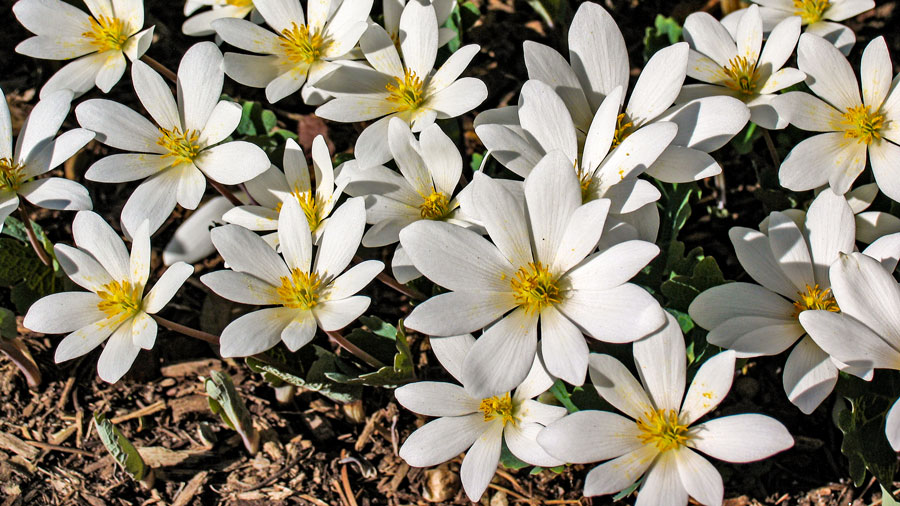
The publisher, author, and interviewees do not recommend picking or using any plants for any reason whatsoever! Please research and know what you're doing before you pick. This article is simply informational about the power of plants.
Ever notice swaths of orange Day Lilies (Hemerocallis fulva) growing in meadows and roadsides? They are a dining experience waiting to happen. All parts of this non-native, garden-escapee are edible. Dr. Randi Eckel, owner of Toadshade Wildflower Farm in Frenchtown, loves using them in salad. "Just take the flower and tear it into strips and toss it into salad and it's beautiful. No need to remove the pollen," she says. Some Day Lilies are sweet and some are peppery. The orange ones are sweet.
Eat the first year root and young tender leaves of the biennial Burdock (Arctium sp.), an "in demand" weed you'll find in abandoned places.. "The Italian women use the first year's rosettes. They boil it up and throw the water off three times, dip it in egg and cracker crumbs," says Cyrus Hyde, owner with his wife Louise, of Well-Sweep Herb Farm in Port Murray. "The Japanese use the second year stem when it's young and tender, and they call it 'gobo.' They dug up the root, dried it, cut it in chunks, strung it and let the baby chew on it for teething."
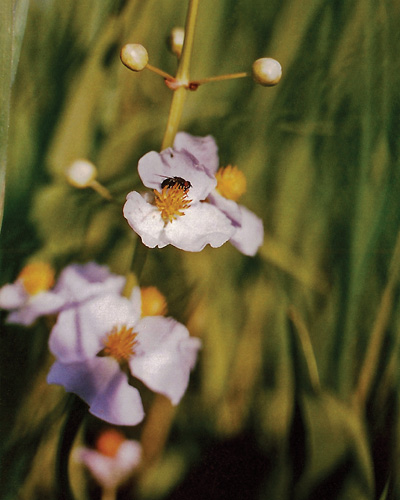
Common Cattail, (Typha latifolia) has several culinary uses. Eat the bases of young shoots in spring: raw, cooked or pickled. Eckel pulls up above-ground stalks, peels them and eats the core. Then, before the flower head emerges from the leaf sheath, harvest and cook it like corn-on-the-cob. In late spring, collect the brown pollen then dry, sift and mix it with flour. In winter make flour out of its roots. It's amazing they're still so prolific.
Duck Potato or broad-leaved Arrowhead (Sagittaria latifolia) produces tubers in huge quantities. Harvest them in early spring or mid-to-late fall, when the plants are dormant. Just disturb the soil in the water and the tubers will float to the surface. Cook them like potatoes, but save some for the ducks.
Mayapple, a.k.a. hog apple, raccoon berry and ground lemon (Podophyllum peltatum) grows in rich woodland. The fruit of this North American native makes delicious jelly. "Know that until the fruit is ripe and turns yellow, all parts of the plant are poisonous," Eckel stresses. "In July-early August, the leaves begin collapsing. The other way to know they're ripe is that they're all gone."

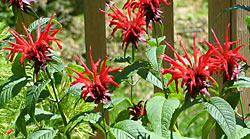
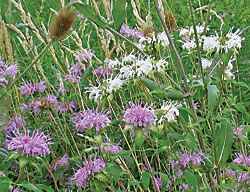
The Mountain Mints (Pycnanthemum sp.) are native to North America and grow in dry fields. Their leaves make delicious teas and the plants are decorative. Short-toothed Mountain Mint (P. muticum) has white leaves beneath the flowers, which enhances their effect.
Oswego Tea or Bee Balm (Monarda didyma) and the North American native, Wild Bergamot (M. fistulosa), grow wild in fields and along roadsides. Leaves of both species make great tea. In fact, the colonists used Oswego Tea, named for upstate New York Indians, as a replacement tea during the Boston Tea Party. According to Newcomb's Wildflower Guide, it is a New England garden escapee. Basil Balm or white bergamot, (M. clinopodia) is another. All three species are valuable garden plants and attract pollinators.
And this writer's favorite: dandelion (Taraxacum officinale), the beyond-maligned Nature's gift for wine, salad greens and making a pretty lawn.
The bulb and leaves of Wild Leek or ramps (Allium tricoccum) are more flavorful than commercially grown leeks. Find them in late March-April in well-drained soil in shade. "The big patches are easy to find because the trees don't have leaves on them yet. They look like lily-of-the-valley," says Rich Sisti, owner Catalpa Ridge Farm in Wantage. You can purchase seed or plants. Wild Onion (A. canadense) and Wild Garlic (A. vineale) encourage the growth of pro-biotics and inhibit bacteria. They are useful against colds, coughs, asthma, bacterial infections, breathing problems and tumors and are anti-clotting agents. Nature's medicine chest!
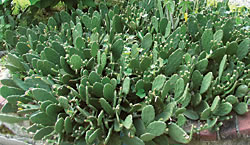
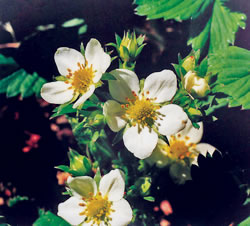
Prickly pear cactus, Opuntia humifusa, is native to eastern North America. Mexican food stores sell the same plant. The fruit is edible; the pads, big thick leaves with spines, are edible too, but you have to wear heavy gloves.
Purslane (Portulaca oleracea) is a weed rampant in waste places with high amounts of Omega-3 fatty acids and protein. It sells for about $15 per pound in New York City.
The wild strawberry (Fragaria virginiana) is a favorite of Eckel. In the 1600s, this eastern North American native was crossed with a South American strawberry to produce the garden strawberry. The wild ones are very small, intensely flavored and found in sunny areas, sometime protected by poison ivy, as this writer found out. Indian mock strawberry (Potentilla indica), an Asian native look-alike, has yellow flowers (our native has white flowers). "If you break open a berry and it's red, it's a strawberry. If it's white, it's mock strawberry," Eckel says.
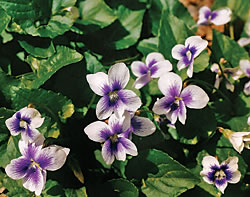
Violets are quite edible. You can cook the leaves like spinach and use the flowers in salads. Crystallized blossoms are gorgeous as garnishes on cakes and candies. In New Jersey, seventeen species are native, and the common blue violet (Viola sororia) is the state flower.
The evergreen Wintergreen (Gaultheria procumbens), has a bright red berry once sold in Boston markets as candy. The leaves were used for wintergreen tea. Now the plant is used for flavoring candy, gum and mouthwash. As an ointment, it relieves muscle pain.
In the early 1500s, Paracelsus, an Austrian itinerant physician/ botanist/ alchemist/ cultist developed the Doctrine of Signatures— "the concept that plants have been put here for human use and that we just had to look at them hard enough to figure out what they were telling us. If the plant looked like a liver, it was good for the liver. If it looked like a snake, it cured snake bites. So we have snakeroot, boneset, bloodroot, lungwort and all kinds of cool stuff. None of this actually worked but it was an interesting concept and this is where some plants got their common names," says Eckel. Enter Cyrus Hyde: "When I was a kid we lived in a house that was over 200 years old. When we went up to the wagon house, there was Joe-Pye Weed and boneset and different other herbs hanging from the ceiling there that they would dry and use in the winter for medicine. Now I lecture on the herbs and bring in history."

American Pennyroyal (Hedeoma pulegioides) repels mosquitoes. Put this annual in a jar of sweet oil—refined olive oil sold in pharmacies—out in the sun for twelve days to extract the menthol. "It's one of the best things to keep around the house to keep the mosquitoes away," says Cyrus Hyde. "It was used for burns because the menthol was cool for the burn and the olive oil healed. It was also used for abortion. In the afternoons, Pennsylvania Dutch women enjoyed a cup of pennyroyal tea, which was cooling and relaxing when they were together. Pregnant women didn't drink the tea."
English and Common Plantain (Plantago lanceolata, P. major) heals bug bites. "If I get stung by a bee I light a match and run it underneath a leaf and wilt it. Then I squeeze it together and about the third time I squeeze it, the juice comes out. Put that juice on a bee sting, mosquito bite, any insect bite, it'll take the sting out, the swelling down and the itch away. I do it all the time," says Cyrus Hyde. "It has been used for scorpion bites and as a poultice to draw the infection out. Smash the leaves and put them on the bite with a cloth and go to bed. By morning the infection is gone. An old lady has problems with her feet. She dips plantain leaves in hot boiling water and wraps them around her feet. She says after a while it makes her feet feel like they're floating." Some people are allergic to plantain.
Tansy (Tanacetum vulgare), once used as an embalming agent and to preserve meat, and common Yarrow (Achillea millefolium) repel Japanese beetles, ants, mosquitoes and flies. Tansy was also used to "calm a number of female discomforts such as hysteria," according to The Rodale Herb Book (Rodale Press). It is also a culinary herb.
Some herbs are dangerous; others are in danger. Take Ginseng (Panax quinquefolius), once found in the rich woods of the Skylands until it was nearly decimated by ginseng hunters for export to the Chinese, who prized it as an aphrodisiac and heart tonic. Also Goldenseal (Hydrastis canadensis), once an official drug, is endangered in New Jersey. They are both now under protection of the Highlands Water Protection and Planning Act. So many other edible and medicinal plants live in New Jersey's wild lands and some, like Goldenseal, are in critical danger of disappearing. You can buy plants and seeds of all the plants mentioned here for your own garden.
Says Cyrus Hyde: "Never use a plant if you're not absolutely certain what it is. Never use it if you just think it is something. Poison hemlock looks a lot like sweet cicely but it's a deadly poison."